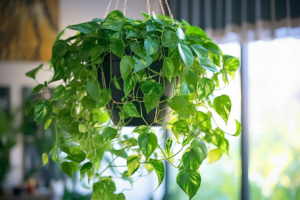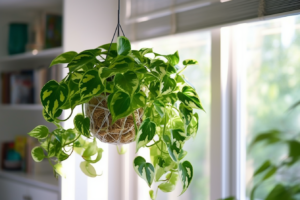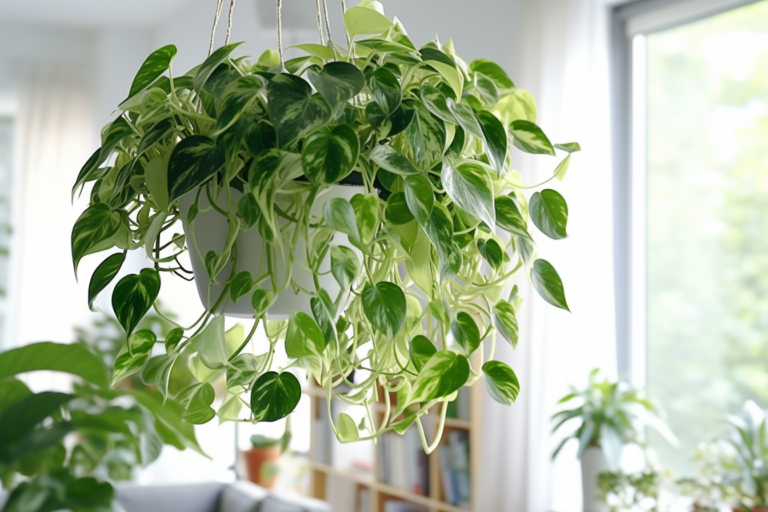Pothos, also known as Devil’s Ivy, is a popular and versatile houseplant that can thrive in a variety of conditions. One of the most common questions asked by new pothos owners is: how often should we water a pothos plant? In this comprehensive guide, we will delve into the specifics of watering your pothos plant, ensuring it remains healthy and vibrant. So, let’s dive in!
If you’re a plant lover like me, you may be wondering how often to water your pothos plant. It’s not always an easy question to answer, as the frequency can depend on several factors. That being said, there are some general guidelines you can follow to keep your pothos healthy and happy.
Pothos plants like moist soil, but they don’t like to be overwatered. Overwatering can lead to root rot, which can be detrimental to the plant’s health. On the other hand, underwatering can cause the leaves to wilt and turn yellow. So, finding the right balance is key. In the next section, I’ll share some tips on how to determine how often to water your pothos.
Understanding Pothos Plants
Before we answer the question of how often to water your pothos, it is essential to understand the plant’s basic requirements. Pothos plants are native to tropical regions and thrive in well-draining soil with indirect sunlight. They are known for their ability to adapt to a variety of environmental conditions, making them a favorite among novice and experienced plant enthusiasts alike.
Types of Pothos Plants
There are several types of pothos plants, each with its own unique characteristics:
- Golden Pothos
- Marble Queen Pothos
- Neon Pothos
- Jade Pothos
- Satin Pothos
While each type may have slight differences in care requirements, the general watering guidelines we discuss in this article apply to all pothos varieties.
Factors Affecting Watering Frequency
Several factors can influence how often you should water your pothos plant. Let’s discuss some of the most important ones:
- Pot Size: Larger pots can hold more water and take longer to dry out, while smaller pots may need more frequent watering.
- Type of Soil: Well-draining soil is essential for pothos plants, as it prevents root rot caused by excess moisture.
- Temperature and Humidity: Higher temperatures and lower humidity levels cause the soil to dry out faster, requiring more frequent watering.
- Light Exposure: Pothos plants placed in brighter locations may need more water than those in low-light areas.
- Plant Growth Stage: Actively growing plants may require more water than those in a dormant state.
How Often Should You Water Your Pothos?
As a houseplant enthusiast, it’s important to know how often to water your pothos to keep it thriving. Overwatering can lead to root rot, while underwatering can cause the plant to wilt and droop. So how often should you water your pothos?

The answer is: it depends. There are several factors that can affect how often you should water your pothos, including the environment it’s in and the size of the plant. Here are some general guidelines to follow:
- Check the soil moisture regularly. Stick your finger 1-2 inches into the soil. If it feels dry at that depth, it’s time to water. If it’s still moist, hold off on watering for a few more days.
- Consider the humidity level in your home. Pothos plants prefer a humid environment, so if your home is particularly dry, you may need to water more often.
- Take into account the size of your pothos plant. Larger plants may require more frequent watering than smaller ones.
It’s important to note that overwatering can be more detrimental than underwatering. If you’re not sure whether your pothos needs water or not, it’s better to err on the side of caution and wait a bit longer before watering.
Here’s a table to summarize the above information:
| Factor | Watering Frequency |
|---|---|
| Soil moisture | Dry 1-2 inches deep |
| Humidity | Higher humidity may require more frequent watering |
| Plant size | Larger plants may require more frequent watering |
In addition to these guidelines, it’s important to make sure you’re watering your pothos properly. Make sure the water is able to drain out of the bottom of the pot, and don’t let the plant sit in standing water. You can also mist the leaves to provide additional humidity.
By following these guidelines and keeping an eye on your pothos plant, you’ll be able to determine the right watering schedule to keep it healthy and thriving.
How Often to Water a Golden Pothos?
Golden pothos (Epipremnum aureum) is a low-maintenance houseplant that can tolerate a range of growing conditions. To water a golden pothos, allow the top inch or two (2.5-5 cm) of soil to dry out between waterings. This typically means watering the plant every 7-10 days, depending on factors such as the size of the pot, the type of soil, and the humidity and temperature of your home. Be sure not to overwater, as this can lead to root rot. Make sure your pot has drainage holes to allow excess water to escape. Adjust your watering schedule if you notice yellowing leaves (overwatering) or wilting (underwatering).
Signs of Over-Watering and Under-Watering
How can you tell if your pothos plant needs more or less water? Here are some signs to look for:
Over-Watering
- Yellowing leaves
- Wilting even with moist soil
- Root rot
- Mold or fungus growth
Under-Watering
- Drooping leaves
- Brown leaf tips
- Slow or stunted growth
- Soil pulling away from the pot’s edges
Pothos Watering Best Practices
Now that we’ve covered the factors affecting watering frequency and the signs of over-watering and under-watering, let’s discuss some best practices for watering your pothos plant:

- Check the Soil Moisture: Before watering, stick your finger about an inch into the soil. If it’s dry, it’s time to water; if it’s still moist, wait a few more days.
- Water Thoroughly: When watering, ensure that the entire root ball is saturated. This can be done by watering the plant until water drains out of the bottom of the pot. Be sure to empty any excess water from the saucer to prevent the plant from sitting in standing water.
- Adjust Watering Frequency Based on Factors: As mentioned earlier, several factors can affect how often you should water your pothos plant. Monitor these factors and adjust your watering schedule accordingly. Generally, watering every 1-2 weeks is sufficient for most pothos plants.
- Use Room Temperature Water: Pothos plants prefer room temperature water, as cold water can shock the roots and cause damage.
- Consider Bottom Watering: If you struggle with over-watering, try the bottom watering method. Place your potted pothos in a tray or basin filled with water and allow the plant to soak up the water through the drainage holes. Once the top inch of soil is moist, remove the plant from the tray and let it drain.
Common Pothos Watering Mistakes
Here are some common mistakes to avoid when watering your pothos plant:
- Inconsistent Watering: Inconsistent watering can lead to stress and poor plant health. Establish a routine and stick to it.
- Over-Watering: As discussed earlier, over-watering can cause root rot and other issues. Always check the soil moisture before watering.
- Using Tap Water High in Chlorine: Chlorine can be harmful to your pothos plant. If your tap water is high in chlorine, consider using filtered or distilled water.
What to Do After Watering Your Pothos
After watering your pothos, it’s important to take a few steps to ensure the plant remains healthy and continues to grow. Here are some things you should do after watering your pothos:

- Let the soil drain: It’s important to let the excess water drain out of the pot after watering. If water accumulates in the pot, it can cause root rot and other problems for your pothos. After watering, wait a few minutes and then tilt the pot to let any remaining water drain out.
- Check the humidity: Pothos plants thrive in high humidity environments, so it’s important to make sure the air around your plant is moist enough to support its growth. You can use a humidifier or place a small tray of water near the plant to increase the humidity levels.
- Monitor the leaves: The leaves of your pothos can tell you a lot about the health of the plant. After watering, make sure to check the leaves for any signs of yellowing, wilting or dryness. If you notice any problems with the leaves, it may be a sign that you need to adjust your watering routine.
- Fertilize (optional): While pothos plants don’t necessarily need fertilization, it can help promote their growth and keep them healthy. If you choose to fertilize your pothos, wait at least a week after watering to apply the fertilizer.
By following these steps after watering your pothos, you can help ensure that your plant remains healthy and vibrant. Remember to monitor the plant regularly and adjust your watering routine as needed.
Other Care Tips for Your Pothos
Aside from watering, your pothos will also need occasional pruning, fertilizing, and cleaning. Here are a few tips to help keep your plant thriving:
- Pruning: Pothos plants can become quite large, so it’s important to prune them regularly to keep them at a manageable size. Prune back any long or straggly stems to encourage shorter, bushier growth. You can also remove any yellow or brown leaves to improve the plant’s appearance.
- Fertilizing: Pothos plants don’t require a lot of fertilizer, but occasional feeding can help keep them healthy and promote growth. Use a balanced liquid fertilizer and follow the instructions on the label. In general, you’ll want to fertilize your pothos once every month or two during the growing season (spring and summer).
- Cleaning: Pothos leaves can accumulate dust and grime over time, which can interfere with their ability to absorb light. Clean your plant’s leaves regularly with a damp cloth or sponge to keep them looking shiny and healthy.
- Repotting: Pothos plants can quickly outgrow their pots, so you may need to repot your plant every year or two. Look for signs that your plant is root-bound, such as roots growing out of the drainage holes in the bottom of the pot. When repotting, choose a pot that’s slightly larger than your plant’s current container and use fresh potting soil.
By following these care tips, you can help ensure that your pothos stays healthy and vibrant for years to come.
Conclusion
In summary, understanding the factors affecting the watering frequency of your pothos plant and recognizing the signs of over-watering and under-watering are essential to keeping your plant healthy. By following the best practices and avoiding common mistakes, you can enjoy a thriving pothos plant for years to come.
FAQS
How often should I water my pothos plant?
Generally, watering your pothos plant every 1-2 weeks is sufficient. However, this can vary depending on factors such as pot size, soil type, temperature, humidity, light exposure, and plant growth stage.
How can I tell if my pothos plant needs water?
Check the soil moisture by sticking your finger about an inch into the soil. If it feels dry, it's time to water. If it's still moist, wait a few more days.
What type of water should I use for my pothos plant?
Use room temperature water, preferably filtered or distilled if your tap water is high in chlorine.
How do I know if I’m over-watering or under-watering my pothos plant?
Over-watering can cause yellowing leaves, wilting with moist soil, root rot, and mold or fungus growth. Under-watering can result in drooping leaves, brown leaf tips, slow or stunted growth, and soil pulling away from the pot's edges.
Can I use the bottom watering method for my pothos plant?
Yes, bottom watering is an excellent method for pothos plants, especially if you struggle with over-watering. Just be sure to remove the plant from the water once the top inch of soil is moist and allow it to drain.


This blog post was really helpful for me! I’ve been struggling with how often to water my pothos, but now I have a better understanding. Thanks for sharing!